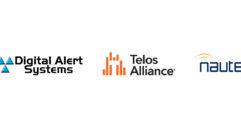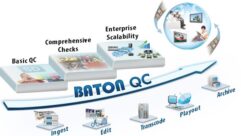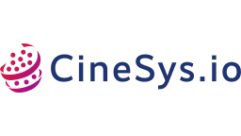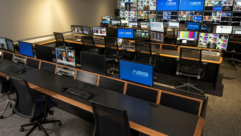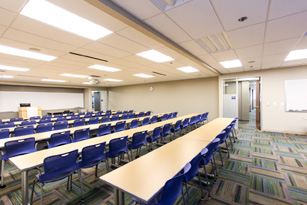
SVC Podcast – Show Notes – Show 133-2:
In this edition of the SVC Podcast, SVC Contributing Editor Bennett Liles continues his discussion with Ken Newbury, Senior Vice President for Operations and Sales Executive with McCann Systems about the installation of conferencing and training facilities in the new Express Scripts headquarters in St. Louis. Ken details the systems installed in the Conference and Training Center, the small collaboration rooms and the new Express Scripts lab where new technologies are showcased.
Links of interest:
- McCann Systems – Audio Visual Systems Design and Integration
- The Cisco SX20 videoconferencing system used in the small collaboration rooms
- The Christie LW551i projectors used in the Conference and Training Center
Download Podcast Here:
https://s3.amazonaws.com/nb-svc/public/public/133-2_McCann_ESI_2.mp3
From Sound & Video Contractor Magazine, this is the SVC Podcast with Ken Newbury of McCann Systems. Show notes for the podcast are available on the web site of Sound & Video Contractor Magazine at svconline.com.
Express Scripts put the emphasis on conferencing and collaboration in their new St. Louis headquarters facility and they called in McCann Systems to install and set up everything. It was a very big job and Ken Newbury from McCann Systems is back to finish up his account on how they got it all in and made it work. That’s coming up right now on the SVC Podcast.
Ken, thanks for being back with us for Part 2 on the SVC Podcast from McCann Systems, the Senior Vice President of Operations and Sales Executive. We were talking in Part 1 about the Express Scripts headquarters in St. Louis that you equipped with conferencing systems and a training facility. I wanted to get into how the training room is used because that one could be a bit of a challenge because the room itself is reconfigurable.
Yes. The room you’re speaking about directly is one of the larger rooms within this new rollout that we built. We have a three-way divisible training/town hall space that in its max capacity I believe can get somewhere upwards of 300 people within the space. All these divisible rooms are the same regardless of how many rooms divide or how large the overall space is. Customers tend to think that they can do every single feature perfectly and the more features that you roll into a room you’ll have slight give-and-takes. So the first thing that we always make sure we do is we get the video right. That tends to be the easiest part. In this case we’re using ceiling-recessed projection screens and sticking with front projection. That was the best way to go about achieving two things; 1. Making sure that we were able to get a large enough image for all participants within the room to see clearly and 2. Also to make sure that we didn’t make a workhorse of a room cost an exorbitant amount of money by doing this rear projection stuff or video walls or some of the other types of technologies that we started to use. After that we look at audio, which starts to pose a challenge. They’re getting local audio reinforced within the room for presentations and such. It’s fairly straightforward. We go about a bunch of ceiling speakers in each room, tie everything back to a nice audio DSP that allows us to combine and separate speaker zones based on the state of the dividing walls, and some wireless microphones so that presenters can clip on a lapel or grab a handheld and have their voices reinforced to any combination of the room based on the size of the meeting. Where we start to have fun is when we also want to make these rooms capable of doing audio conference. It’s one thing when you’ve got a far end coming into the speakers so everybody can hear. And when you’ve got one or two presenters with a wireless microphone speaking to the far end of a phone line, everything’s great. This particular customer liked the idea of making sure that everybody can be heard within a room during a large-scale town hall. So when things like this come into play we start looking at covering the room with ceiling microphones, zoning them based on the room, using auto mixes within our DSP so that we can manage the number of microphones that are open at any given time, and playing the never-ending balancing act between EQ and the properties of a phone line to make sure that things sound good to the folks on the far end. [Timestamp: 3:36]
Yeah, the sound can definitely be tricky in that reconfigurable room. How do they change that, with sliding partitions?
Yeah. This one is sliding partitions. Again, that’s kid of the best way to keep costs down. We’ve had some fun working on jobs where they fold up into the ceiling, but this particular one is all the standard packable sliding partition walls. [Timestamp: 3:55]
And why did you decide to use the Christie LW555 projector in there? Was that cost or the feature set or are you just familiar with using those as sort of a proven product?
You know, it’s a little bit of both and when you’ve got a company like Express – and we do all of their work throughout the United States – just managing inventories, spares and lamps becomes a challenge. So it’s always best to kind of standardize on a single style of unit as long as you can. The LW551 works out well A. For its affordability. It’s a high/bright projector, 5500 lumens, which going to allow it to work for the majority of the training and general presentation type rooms that you’ll put together, and B. We know the product. So we can send a guy in and we can get a lamp changed in less than five minutes. We inventory a couple of spares of everything here in our warehouse so that anywhere in the U.S. if a projector goes down we just send a replacement, they throw it up while the next one gets repaired and it allows us to help minimize down time. [Timestamp: 4:57]
And I think you have a small or medium-sized executive meeting room in there, too, so how did you equip that one?
Yeah, so we’ve actually got a bunch of those within that building as well as in the campus here. The room that we’re about to talk about, there’s probably 40 of these that we’ve deployed even throughout the – just in the U.S. in the last three years. But its premise is simple and feature-packed. We’ve got dual displays on the front wall, one that we dedicate for content, the other that we dedicate for video conferencing. We’re using all Cisco Codecs for this so it’s either a C-series C-60 or the new SX-80 depending on when the room was put in. We’re using ceiling microphones in all of these rooms just to keep the tabletops clear. We’ve got Biamp audio DSP’s for our microphone mixing as well as our tie-in to a phone line, and a Crestron touch panel that is located on the tabletop for control of all the functions. So the idea is that somebody could walk in, very quickly type in a meeting I.D. Our system will connect them directly to their Cisco MCU Bridge, allow them to merge quickly with their other participants, view their content using a WebEx, and make their audio conference calls at the same time. And we made it so that the rooms shut down automatically if it doesn’t see movement for 45 minutes so that if somebody takes a long lunch and decides not to come back we’ve got the technology to turn it back off and get ready for the next group. [Timestamp: 6:23]
That’s great especially when you’re using projectors with fairly expensive lamps. So how are the acoustics? Did you have any acoustic challenges? It sounds to me like these rooms were already laid out pretty well so you didn’t have to take any heroic measures on the sound of the rooms.
No. I mean they were okay. These rooms were slightly a bit more utilitarian I that the amount of money that we allocate to the non-technical aspects of the design were slightly less than the larger boardroom that we talked about earlier. So you might get a room that has – there’s no tack board, there’s no acoustical treatment on the wall so we’ve just got to play that game of making sure we can get the microphones positioned away from any HVAC, drop them down as low as we can without them becoming an eyesore, and then the magic really comes in the configuration of the software making sure that we can use our noise cancellation and our auto mixing to mitigate as much noise as we can and then manipulate the equalization to improve the intelligibility of the direct sound as much as we can while ignoring any of the secondary reflections. [Timestamp: 7:27]
In the small collaboration spaces there is going to be a wide variety of people using those so how much training is needed to operate those systems?
So in the small rooms the smaller kind of four-person rooms that we put out there, these rooms are great. It’s actually a new design that we just started doing with Express. Still dual display but much smaller based on the type of table that we’re using and the seating capacity. We’re using a smaller scale Cisco SX-20 in these, maintaining the use of the Cisco microphone that ships in the box and using the Cisco dialer that comes in the box. So the idea here is keep it simple, keep it easy so training is fairly basic. One nice thing that Express Scripts does is all of their end points are connected to a main MCU bridge and all of the dialing is based on meeting I.D.’s. So you don’t have to worry about keeping an address book or any IP address of who you want to talk to. Every individual gets assigned their own five-digit meeting I.D. and when you send out a meeting invite you simply tell them the I.D., you go into any room, type in those five numbers, hit connect and within about five seconds your rooms are merged and you’re up and running. So a bit of it is with our technology making it easy, but on the IT side they also did a great job making sure that the self-service model for video conferencing would be as similar to a traditional audio conference meeting and meeting I.D. function that folks are already used to. [Timestamp: 8:51]
I guess that once you finish the system the training can be a hurdle depending on the people who are going to be using it, but it appears that training wasn’t really a big problem on the whole thing.
No. They had their moments. The one thing that we tried to do, especially for larger-scale rollouts like this one where you’ve got multiple end users. We go through our initial training when a job is done and make sure that everybody’s happy, but you know we never turn our back on anybody. So if they call us up and say, “I forgot how to do this,” or if we’ve got a new group of users and they’re having issues, I’d rather spend my time and money having my techs give additional training than have them going out there consistently dealing with user error problems and fixing things that aren’t broken. So we really stay with our users. We make sure we get them trained. We make sure we get them comfortable because a properly-operated system tends to have far fewer service calls and emergencies pop up. [Timestamp: 9:41]
And everybody stays a little calmer on the other end. So how much time did you have? What was the timeframe on getting all of this done?
Well, this building that we’re talking about now, this was a ground-up construction so it started as just a flat path of dirt out off the highway. So we just stayed in line with the construction schedule. I want to say start to finish it was probably an eight or nine month construction process and we were involved from before groundbreaking. The design was identified before the job went out to bid. The AV drawings were completed and included with the general contractor’s bid documents when it did go out so there were no, “Oh, we forget about AV” moments where they didn’t have infrastructure, conduit or room allocated for racks and things like that. So when we’re lucky to get with a good construction crew and a good project team from the beginning we’re just another trade on the site at that point. The only time it gets difficult is at the very, very end when all the furniture is in and they’re ready to move in and we’ve still got a little bit of that last commissioning and configuration to do. But anyone that installs AV systems for a living knows exactly what that is. I don’t think that part of the job is ever going to go away; that last couple of weeks is always a hurdle. [Timestamp: 11:00]
Well, coordinating all of those trades especially on a from-the-ground-up project is always a balancing act. What would you say was the biggest challenge on this one? Was there anything particularly hard to deal with?
When you’ve got jobs of this size a lot of it turns into just managing resources. You’ve got a lot of work that’s got to get done and sometimes schedule conflicts create things to compress or expand. And just kind of seeing the future as best as you can, I guess, right, and making sure you know when to pull your guys back for a couple of days and when it makes sense to put a couple of extra bodies out on site to play catch up. Just keep your eyes on everything because you might not think that the plumbing in the building will affect your AV. You realize it might when you’ve got a projector that you need to hang right above a sprinkler pipe. So it’s just having a good understanding of the overall construction process and how everybody interacts and has the ability to interfere with everybody else, and addressing it and fixing it before it becomes a problem for someone. [Timestamp: 12:00]
I know that you install a lot of conferencing facilities like this one, but on the Express Scripts project there was a very special area they wanted done with some fairly unusual aspects to it.
Kind of the way cooler part of what we’ve been doing here recently in St. Louis is The Lab facility that we built for them within this headquarters campus. That’s where it’s got all the real kind of really neat custom stuff – big touchscreen video walls, display panels that we can turn around 360 degrees and track 30 feet across a wall, custom software development, real-time metrics, touch tables, all kinds of crazy stuff. [Timestamp: 12:33]
What is it that they actually want to do in The Lab? How do they plan to use it?
Express Scripts hired an experiential designer, Clickspring, out of New York City to come in and help them establish and identify who they were and to help them build a facility that would allow them to bring existing and potential customers in to see how Express Scripts is working to better the pharmaceutical industry and the care management aspect of pharmaceuticals. So with that we birthed the place called The Lab here in the St. Louis main campus and it’s really a neat space. It’s very rich with high-end architectural design, but it is very rich with cutting-edge technology that they use at each of these glorified tour stops that tell the story of who Express was, who they are, and who they’re going to become. So as we work out way through this facility we’ve got a gauntlet of kind of one-off neat AV vignettes ranging from 103-inch plasma displays with touchscreen overlays built inside of a custom wall that can turn 180-degrees on a pivot so that you can alter the location of your meeting space depending on the size of your group. From there we move to a large atrium where we have a 4 x 4 video wall of slim bezel flat panels video fed from a Vista Spyder controlled from an iPod with custom content created by one of our software developers, X.2.0, that we use to show real-time metrics of health statistics within the Express Scripts customer base. [Timestamp: 14:13]
That’s going to be the kind of facility that the top people are going to love to show off to the guests just for the “Wow” factor and to demonstrate what you can do.
Well, that’s exactly what it is. They’ve built the facility to help sell their brand, so it’s essentially a sales center to help people to lock down new customers and clients to show them what they’re doing to improve the pharmaceutical business that they’re wrapped up in. [Timestamp: 14:33]
Were your people working on this in the same timeframe or was this done separately after others were finished?
This Lab was actually a space that we were building concurrently at the same time that we were doing two other buildings within the same campus. So aside from staffing challenges, there’s also the logistics of managing multiple large-scale jobs at the same time. [Timestamp: 14:56]
Now we talked about the training in the other areas, but the lab sounds like it has so much high-tech stuff in it that the learning curve would be pretty steep.
This is totally different in the regard that there’s a few tour guides that are designated for this space. So making sure that they’re up to speed with using the system and able to do that so flawlessly in the face of a 10 or 20-peson group is a challenge. So it goes back to streamlined interfaces, the least amount of buttons for the most amount of reactions, and a back end that is robust and isn’t going to have any service issues. [Timestamp: 15:31]
And that all ties in with the general control philosophy of keeping it user-friendly and automating various sequences of events and like that?
Yeah, that’s right. I mean this Lab facility that we’re talking about has – between two AV rooms we’re looking at nine full-height AV cabinets full of gear to make this entire single system connect. But with all those electronics and blinking lights in the background we make sure that anything that the user sees or interacts with automates that process exactly. So even though there’s a handful of things happening behind the scenes and levers and switches and smoke and mirrors, one button does it all, two buttons does the rest and move onto the next thing. [Timestamp: 16:12]
And there was probably something in there that could have been a special situation that kind of stretched what you could do or even to visualize how it would work.
Yeah, there’s some really neat stuff that we’ve done here, things that were brand new for us. We always invite a challenge. I’d say the most interesting thing that we did on this one that had us scratching our head but smiling at the end is two video wall layouts that we built onto a custom wall that not only spun 360 degrees around, the wall itself was also a movable partition that slid along a track 40 feet either direction within the center of the Lab. Not only did we have to design the way to make a display spin and stay turned on, we had to work out trenching down in the floor, running all of our power and signal cabling within an Igus Chain floor track and make sure that folks could move that wall, spin that screen and have the technology continue to operate. [Timestamp: 17:08]
Well, that sounds like it must have been the most fun part then.
All the way down to the airlines that we put into the system so that with an IR plane you can move your hand in front of the lever which releases the air brake that allows you to then move that wall, and as soon as you remove your hand the air brake reengages so that you never run into a situation that a display wall is sliding out of control down a track. [Timestamp: 17:35]
It’s always great when it’s finally done and you see people actually using it and being knocked over with the things they can make it do. Thanks for telling us about it. It’s Ken Newbury, Senior Vice President of Operations and Sales Executive with McCann Systems and the Express Scripts headquarters conference, training and collaboration systems. Sounds like it all came out pretty well.
Yeah, we had a good time on that one.
Alright, Ken. Thanks for being with us.
Happy to be here. Thanks for having the conversation.
Thank you for being here with us for the SVC Podcast with Ken Newbury of McCann Systems. Show notes are available on the website of Sound & Video Contractor Magazine at svconline.com. Be back here with us next time for the SVC Podcast.



